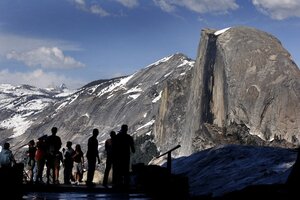A Yosemite moment for nations in conflict
The 150th anniversary of Lincoln's act to preserve Yosemite valley during the Civil War serves as a reminder of how the shared experience of landscape can help unite a people.

Visitors view Half Dome from Glacier Point at Yosemite National Park, Calif.
AP Photo/file
For those people whose countries are on the verge of divorce, such as in war-wracked Iraq or in Britain with its coming secession vote in Scotland, it may be helpful to note an important 150th anniversary in the United States.
On June 30, 1864, at the height of the American Civil War, Abraham Lincoln took time from saving the Union to sign a two-paragraph law that set aside Yosemite valley and a nearby sequoia forest in California “for public use, resort, and recreation ... inalienable for all time.” This act of preservation later became the basis for the national parks, such as Yellowstone, the Smokies, and the Everglades.
Today in their songs (“purple mountain majesty”) and their tourism (273 million visitors a year to the parks), Americans are united in reverence for a shared landscape. They join year-round in experiencing the natural qualities of beauty, quietude, freedom, and awe in wilderness. Stephen Mather, the first director of the National Park Service, said the parks allow Americans “to love more deeply this land in which they live.”
Humans have long bonded into communities for a variety of reasons: ethnicity, language, religion, history and, in recent centuries, the civic ideals of democracy. This desire for common identity also derives from qualities found in landscape. A person’s place in society is often defined by the meaning and aspirations attached to “place.” A common land helps shape the customs of a people. Customs then lead to morality and laws. A natural geography thus helps define the body-politic. In fact, the “scape” in landscape refers to “shape,” or the underlying foundation that leads to unity.
In America, a reverence for nature even comes with its high priests, such as John Muir, Henry David Thoreau, Frederick Law Olmsted, and Rachel Carson. Many cities and towns still gather in the “commons,” or a central piece of land that evokes openness and inclusiveness.
People in Britain today may forget how King James I in the early 1600s tried to unite England and Scotland into “Britain” by suggesting a transcendent bond. He fused these different people by putting on plays about the idyllic scenery of their common countryside. (He also tried to unite Christians with an authoritative translation of the Bible.)
Iraq’s borders were imposed by colonial powers a century ago but they still represent a shared geography of rivers, mountains, trade routes, and other markers of “place.” This heritage has historically helped Iraqis to overcome differences. Today many Sunnis and Shiites in Iraq are married to each other or form other bonds, a fact lost in all the reporting of conflict between these two branches of Islam.
People within a group often focus more on differences than on what unites them. Americans, too, often forget this. If only politicians in Washington could encamp each summer to Yosemite and share the spiritual experience of its waterfalls, valleys, and cliffs, they might enjoy more unity of purpose.
The 150th anniversary of Yosemite is an occasion for all peoples to note that, even during a civil war, the qualities of landscape can help bind a nation.

